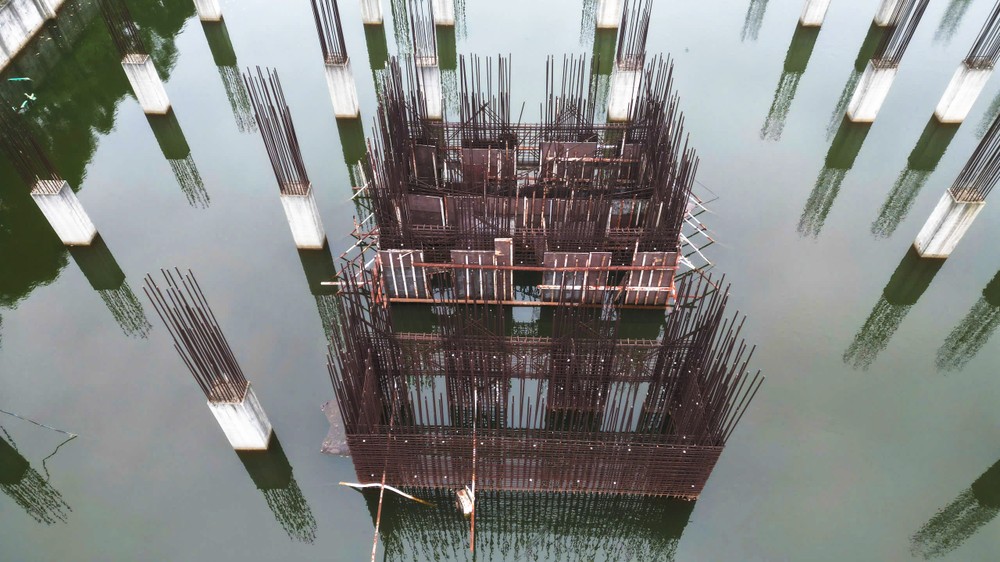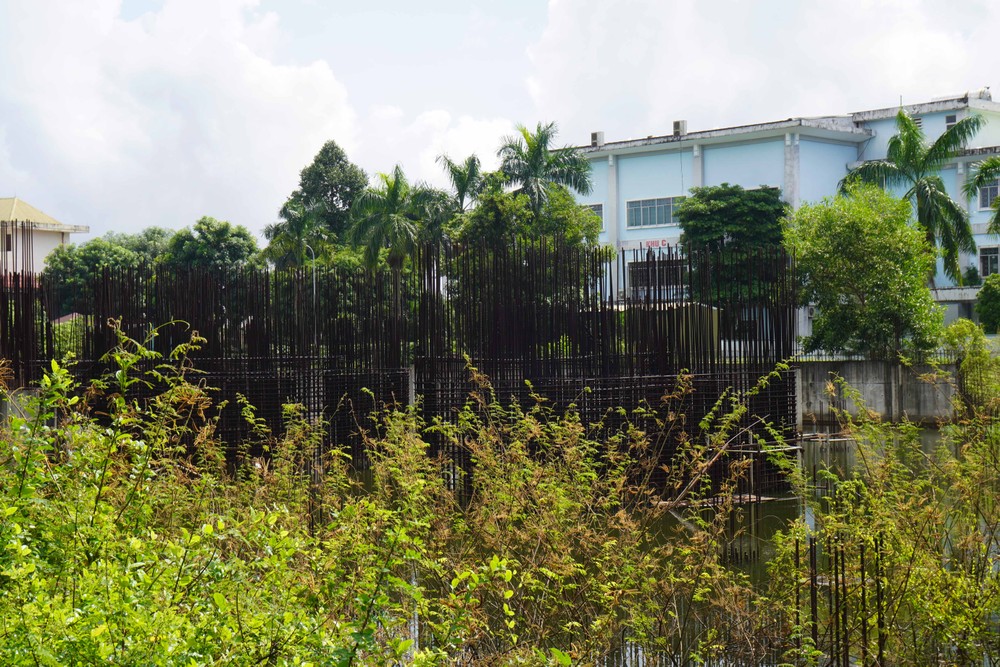
Despite receiving investments of trillions of Vietnamese dongs, they have either been left "clinically dead" midway or fallen into a state of abandonment, leaving tens of thousands of patients disappointed and bewildered.
Closed after inauguration
On an early autumn day, a team of SGGP Newspaper reporters visited Phu Ly City (Ha Nam Province) and witnessed the desolate, abandoned state of two major facilities: the second branch of Bach Mai Hospital and the second branch of Vietnam-Germany Friendship Hospital. Each hospital was designed to accommodate 1,000 beds on a site spanning approximately 21 hectares, with a total investment of over VND4.5 trillion.
Thousands of residents in the Red River Delta and North Central regions have eagerly awaited the opening of these hospitals, hoping to escape the overcrowded treatment conditions in Hanoi. However, the reality has been disappointing. At the Bach Mai Hospital project, although roughly 90 percent of construction is complete, only wild grass now covers the area. Some buildings show signs of peeling paint, mold, and moss. In some parts of the site, stagnant water has collected, and locals have repurposed the grounds for grazing livestock and releasing ducks.
Construction of these two hospital facilities began in 2014, and by October 2018, their outpatient departments had been completed and inaugurated. However, things quickly took a turn for the worse. The second branch of Vietnam-Germany Friendship Hospital has remained idle for six years since its inauguration, never admitting a single patient. Similarly, the outpatient department of Bach Mai Hospital operated briefly from March 2019 to March 2020 before shutting down. These two projects were specifically mentioned by General Secretary To Lam during a discussion on the socio-economic situation at the 8th session of the 15th National Assembly on October 26. Despite substantial State funding over the years, both projects remain stalled, resulting in significant waste.
The Prime Minister's Task Force identified key issues with contractor selection and contract agreements. Problems with the bidding process and noncompliant payment terms in the contracts led to payments exceeding the awarded bid price, violating the Law on Bidding. A representative from the project management board attributed these issues to inexperience, as this was their first time handling such a project. They admitted to underestimating the challenges and unforeseen complications during implementation.
Seven years ago, the groundbreaking of the High-Quality Service Zone Project at Quang Ngai Provincial General Hospital, with an investment exceeding VND1.1 trillion, was met with joy and anticipation. It was set to become one of the most modern hospitals in Central Vietnam. However, a visit to the site in late November revealed a disheartening reality: the area is now an overgrown wasteland, enclosed by moss-covered concrete walls. Within the "high-tech medical zone," the entire site is engulfed in overgrown weeds and dense bushes, resembling a miniature jungle in the heart of Quang Ngai City. At the center of this unintended "wilderness" lies a stagnant pond, surrounded by numerous rusting steel bars.
Nguyen M.A., a 67-year-old retired official from Nghia Lo Ward, voiced his disappointment, recalling how residents had placed great hopes on the project, only to see it "die" before construction truly began. Le Toan, a neighbor of the site, expressed outrage over the prolonged inaction, describing it as a polluted wasteland filled with stagnant water and debris.
The project, a joint venture between Quang Ngai General Hospital and private partners, was planned as a 500-bed facility with eight international-standard operating rooms, designed to meet type-I hospital standards on a 11,000 square meters site. It received government incentives under healthcare privatization policies. Construction began in June 2017 but came to a halt in the second quarter of 2020 and has remained stagnant ever since.
Inspections by Quang Ngai provincial authorities revealed multiple violations involving the Departments of Planning and Investment and Natural Resources and Environment, including failing to complete necessary land-use approvals, improperly granting and leasing land, and allowing unauthorized construction. In addition, the land was not utilized within the required timeframe, and asset valuation and equity contribution processes were found to be unlawful. In October 2023, the provincial government revoked the project's land rights and transferred the 1.1-hectare plot to the Land Fund Development Center for management and auction.
Despite these measures, the project remains unresolved. Quang Ngai General Hospital's partners have already invested VND147 billion, complicating the situation. A representative from the Quang Ngai Department of Finance stated that the department has sent seven formal requests for project-related legal documents from the investors but has yet to receive a response. The project was inadequately documented from the start, making asset valuation extremely difficult.
A senior official from the Department of Finance shared concerns about the challenges ahead: "We now face a two-step process—appraising the land value and the remaining value of the construction. The structure is buried underground, while the legal documentation sits with the Department of Health and the provincial general hospital."
The oncology hospital project "left to decay"
Traveling further South, SGGP reporters visited the Can Tho Oncology Hospital Investment Project, a 500-bed facility with a total investment of VND1.7 trillion. Once hailed as the future of cancer treatment in the Mekong Delta, the hospital was expected to address the healthcare struggles of millions in the region. Yet, 17 years after its groundbreaking in November 2007, the project has devolved into an enormous, unfinished concrete structure, leaving behind significant consequences.
A visit to the site in late November 2024 painted a bleak picture. The nearly 15,000 square meters campus stood abandoned, overtaken by dense weeds. Construction materials, cranes, scaffolding, and machinery lay scattered across the grounds, and many sections of the building remained incomplete. Years of neglect had caused visible damage, with walls peeling, deteriorating, and covered in moss. Rainwater had pooled on the rooftops and ground floors, creating stagnant, foul-smelling puddles. Outside, the metal fencing and project signs were faded and warped.
Witnessing a trillion-Vietnamese-dong project left abandoned for years, many local residents are filled with regret and frustration. Cao Phong Hoang, a resident of An Binh Ward in Ninh Kieu District, Can Tho City, who lives next to the site, expressed, "This long-abandoned project has not only caused a significant loss of State funds but also wasted valuable land in the heart of Can Tho City, where land has high usage potential. The bigger issue is that millions of people in the Mekong Delta have no easy, timely access to healthcare. For patients with serious illnesses, their chances of survival are diminished because they have to travel to Ho Chi Minh City for treatment, which is both far and costly."
Ha Kim Huong, also a resident near the project, raised similar concerns. In addition to the financial waste, she pointed out that the site has become a source of environmental pollution and a breeding ground for disease. Locals have repeatedly voiced these concerns in community meetings. Each time, city officials explained that financial issues were delaying the project and promised to resolve them soon, asking for patience. However, there is still no clear timeline for when the hospital will be completed.
According to findings, the project has completed only about 21 percent of the total value of the EPC (design, equipment supply, technology, and construction) contract. Specifically, the construction phase has reached 82 percent, while the equipment supply and installation phase is only about 16 percent complete. The delays are mainly due to issues with adjustments to medical equipment and the supply and installation phases. By July 10, 2022, the contract between the Can Tho Department of Health (the project's investor) and the contractor consortium expired, leading to the project's stagnation for the past two years.
Deputy Minister of Health Le Duc Luan explained that the construction of the second facilities of the Bach Mai and Vietnam-Germany Friendship hospitals (in Ha Nam) began in 2015. However, throughout the construction process, many challenges arose regarding the implementation of the contract. In early 2021, construction was halted, and since then, these issues remain unresolved, with no clear mechanism to address the difficulties faced by the project.
Recently, the Government's Task Force and the Ministry of Health have conducted multiple reviews of the project’s documents, thoroughly evaluating the legal issues and violations involved. They have identified key obstacles that need to be addressed and proposed solutions for resolution. The Ministry of Health is working with other relevant ministries to find feasible solutions and will soon present them to the authorities for approval to resolve these challenges. Currently, the Bach Mai hospital project is over 90 percent complete, while the Vietnam-Germany Friendship Hospital project is about 60 percent finished.
The VND1.1 trillion high-quality hospital project in Quang Ngai stands engulfed in dense bushes and wild grass, presenting a neglected appearance in the heart of Quang Ngai City.

































